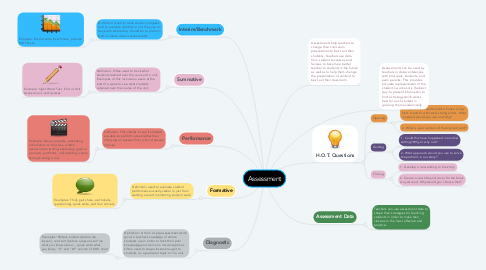
1. Formative
1.1. Definition: used to evaluate student performance usually verbal or just from walking around monitoring student work.
1.1.1. Examples: Think pair share, exit tickets, questioning, quick write, and four corners.
2. Interim/Benchmark
2.1. Definition: Used to track student progress and to evaluate whether or not they are on track with where they should be to preform well on future district assessments.
2.1.1. Example: District wide benchmark, practice MAP tests
3. Summative
3.1. Definition: Often used to track what students learned over the course of a unit. Examples of this include an exam at the end of a week to see what students retained over the course of the unit.
3.1.1. Example: Sight Word Test, End of Unit Assessment, and quizzes
4. Performance
4.1. Definition: This checks to see if students are able to preform a task rather than choosing an answer from a list of answer choices.
4.1.1. Example: Group projects, presenting information to the class, written assessments (writing expository given a prompt), portfolios, and retelling a story through acting it out.
5. Diagnostic
5.1. Definition: A form of pre-assessment which gives a teacher knowledge of where students are in order to track their prior knowledge and common misconceptions. Often used to shape lessons taught to students on a particular topic or in a unit.
5.1.1. Examples: Pretest, kahoot (before the lesson), card sort (before a lesson), tell me what you know about ___, quick write what you know, "K" and "W" column of KWL chart
6. H.O.T. Questions
6.1. Opening
6.1.1. 1. Suppose you could build a house of any kind. It had to withstand strong winds. What materials would you use and why?
6.1.2. 2. What is your opinion of the big bad wolf?
6.2. Guiding
6.2.1. 1. Could this have happened in another setting? Why or why not?
6.2.2. 2. What approach would you use to solve the problem in our story?
6.3. Closing
6.3.1. 1. Develop a new ending to the story.
6.3.2. 2. Create a new title and cover for the book we just read. Why would you choose that?

